How Climate Change Affects River and Lake Water Temperature in Central-West Poland—A Case Study of the Warta River Catchment
Abstract
:1. Introduction
2. Materials and Methods
2.1. Study Site Area
2.2. Materials
2.3. Data Reconstruction
2.4. Analysis of the Direction and Extent of Temperature Changes
3. Results
3.1. Air Temperature
3.2. River Water Temperature
3.3. Lake Water Temperatures
3.4. Comparison of the Extent of Changes in Air and Water Temperatures
4. Discussion
5. Conclusions
Supplementary Materials
Author Contributions
Funding
Institutional Review Board Statement
Informed Consent Statement
Data Availability Statement
Conflicts of Interest
References
- Virdis, S.G.; Soodcharoen, N.; Lugliè, A.; Padedda, B.M. Estimation of satellite-derived lake water surface temperatures in the western Mediterranean: Integrating multi-source, multi-resolution imagery and a long-term field dataset using a time series approach. Sci. Total Environ. 2019, 707, 135567. [Google Scholar] [CrossRef] [PubMed]
- Araźny, A.; Kejna, M.; Wawrzyniak, T.; Osuch, M.; Plenzler, J.; Budzik, T. Zmiany klimatu w ekosystemach Arktyki i Antarktyki. Kosmos. Probl. Nauk. Biol. 2021, 4, 579–595. [Google Scholar] [CrossRef] [PubMed]
- Vásquez, C.; Aguirre, C.; Choccña, M.; Guerrero, J. Variabilidad interanual de la temperatura super cial del lago Titicaca usando imágenes MODIS del invierno (2001–2014). Rev. Investig. Física 2022, 25, 10–18. [Google Scholar] [CrossRef]
- Ptak, M.; Sojka, M.; Kałuża, T.; Choiński, A.; Nowak, B. Long-term water temperature trends of the Warta River in the years 1960–2009. Ecohydrol. Hydrobiol. 2019, 19, 441–451. [Google Scholar] [CrossRef]
- Rivaes, R.P.; Feio, M.J.; Almeida, S.F.P.; Calapez, A.R.; Sales, M.; Gebler, D.; Lozanovska, I.; Aguiar, F.C. River ecosystem endangerment from climate change-driven regulated flow regimes. Sci. Total Environ. 2022, 818, 151857. [Google Scholar] [CrossRef] [PubMed]
- Kasushal, S.S.; Linkes, G.E.; Jaworski, N.A.; Pace, M.L.; Sides, A.M.; Seekell, D.; Belt, K.T.; Wingate, R.L. Rising stream and river temperatures in the United States. Front. Ecol. Environ. 2010, 8, 461–466. [Google Scholar] [CrossRef]
- Marszelewski, W.; Pius, B. Long-term changes in temperature of river waters in the transitional zone of the temperate climate: A case study of Polish rivers. Hydrol. Sci. J. 2016, 61, 1430–1442. [Google Scholar] [CrossRef]
- Nowak, B.; Skolasińska, K.; Stanek, P. Zmiany warunków termicznych i lodowych rzeki Warty w Sieradzu w wieloleciu 1956–2014. In Varia. Prace z Zakresu Geografii; Bogucki Wydawnictwo Naukowe: Poznań, Poland, 2019; pp. 27–46. [Google Scholar]
- Ptak, M. Zmiany temperatury wody i zjawisk lodowych rzeki Ner (centralna Polska) w latach 1965–2014. Pol. J. Sustain. Dev. 2017, 21, 49–56. [Google Scholar] [CrossRef]
- Ptak, M.; Nowak, B. Zmiany temperatury wody w Prośnie w latach 1965–2014. Woda-Sr.-Obsz. Wiej. 2017, 17, 101–112. [Google Scholar]
- Van Vliet, M.T.H.; Ludwig, F.; Zwolsman, J.J.G.; Weedon, G.P.; Kabat, P. Global river temperatures and sensitivity to atmospheric warming and changes in river flow. Water Resour. Res. 2011, 47, 1–19. [Google Scholar] [CrossRef]
- Žganec, K. The effects of water diversion and climate change on hydrological alteration and temperature regime of karst rivers in central Croatia. Environ. Monit. Assess. 2012, 184, 5705–5723. [Google Scholar] [CrossRef]
- EEA. Woda to Życie. Sygnał EEA 2018; Europejska Agencja Środowiskowa: Kopenhaga, Dania, 2018; p. 79. [Google Scholar] [CrossRef]
- Zalewski, M.; Izydorczyk, K.; Kiedrzyńska, E.; Jarosiewicz, P.; Czerniawski, R. Ekohydrologia dla kompensacji antropopresji i łagodzenia skutków zmian klimatu w ekosystemach rzecznych. In Funkcjonowanie i Ochrona Wód Płynących; Czerniawski, R., Bilski, P., Eds.; Uniwersytet Szczeciński: Szczecin, Poland, 2019; pp. 5–20. [Google Scholar]
- EEA Report No 1/2017. Climate Change, Impacts and Vulnerability in Europe 2016; An Indicator-Based Report; European Environment Agency: Copenhaga, Denmark, 2017; p. 419. [CrossRef]
- IPCC, 2022: Summary for Policymakers. In Climate Change 2022: Impacts, Adaptation, and Vulnerability. Contribution of Working Group II to the Sixth Assessment Report of the Intergovernmental Panel on Climate Change; Pörtner, H.-O.; Roberts, D.C.; Tignor, M.; Poloczanska, E.S.; Mintenbeck, K.; Alegría, A.; Craig, M.; Langsdorf, S.; Löschke, S.; Möller, V.; et al. (Eds.) Cambridge University Press: Cambridge, UK; New York, NY, USA, 2022; pp. 3–33. [Google Scholar]
- Isaak, D.J.; Wollrab, S.; Horan, D.; Chandler, G. Climate change effect on stream and river temperatures across the northwest U.S. from 1980–2009 and implications for salmonid fishes. Clim. Change 2012, 113, 499–524. [Google Scholar] [CrossRef]
- Pekárová, P.; Miklánek, P.; Halmová, D.; Onderka, M.; Pekár, J.; Kučárová, K.; Liová, S.; Škoda, P. Long-term trend and multi-annual variability of water temperature in the pristine Bela River basin (Slovakia). J. Hydrol. 2011, 400, 333–340. [Google Scholar] [CrossRef]
- Arora, R.; Tockner, K.; Venohr, M. Changing river temperatures in northern Germany: Trends and drivers of change. Hydrol. Process. 2016, 30, 3084–3096. [Google Scholar] [CrossRef]
- Wrzesiński, D.; Graf, R. Temporal and spatial patterns of the river flow and water temperature relations in Poland. J. Hydrol. Hydromech. 2022, 70, 12–29. [Google Scholar] [CrossRef]
- Graf, R.; Wrzesiński, D. Zróżnicowanie czasowo-przestrzenne tendencji zmian termiki wód rzecznych w Polsce. In Naturalne i Antropogeniczne Zmiany Obiegu Wody. Współczesne Problemy i Kierunki Badań; Wrzesiński, D., Graf, R., Perz, A., Plewa, K., Eds.; Bogucki Wydawnictwo Naukowe: Poznań, Poland, 2020; pp. 145–160. [Google Scholar]
- Hannah, D.M.; Garner, G. River water temperature in the United Kingdom: Changes over the 20th century and possible changes over the 21st century. Prog. Phys. Geogr. 2015, 39, 68–92. [Google Scholar] [CrossRef]
- Ketabchy, M.; Sample, D.J.; Wynn-Thompson, T.; Nayeb Yazdi, M. Thermal evaluation of urbanization using a hybrid approach. J. Environ. Manag. 2018, 226, 457–475. [Google Scholar] [CrossRef]
- Nelson, K.C.; Palmer, M.A. Stream temperature surges under urbanization and climate change: Data, models, and responses. J. Am. Water Resour. Assoc. 2007, 43, 440–452. [Google Scholar] [CrossRef]
- Lammers, R.B.; Pundsack, J.W.; Shiklomanov, A.I. Variability in river temperature, discharge, and energy flux from the Russian pan-Arctic landmass. J. Geophys. Res.-Atmos. 2007, 112, 1–15. [Google Scholar] [CrossRef] [Green Version]
- Webb, B.W.; Nobilis, F. Long-term changes in river temperature and the influence of climatic and hydrological factors. Hydrol. Sci. J. 2007, 52, 74–85. [Google Scholar] [CrossRef]
- Yang, R.; Wu, S.; Wu, X.; Ptak, M.; Li, X.; Sojka, M.; Graf, R.; Dai, J.; Zhu, S. Quantifying the impacts of climate variation, damming, and flow regulation on river thermal dynamics: A case study of the Włocławek Reservoir in the Vistula River, Poland. Environ. Sci. Eur. 2022, 34, 3. [Google Scholar] [CrossRef]
- Álvarez-Troncoso, R.; Benetti, C.J.; Sarr, A.B.; Pérez-Bilbao, A.; Garrido, J. Impact of hydroelectric power stations on Trichopter assemblages in four rivers in NW Spain. Limnologica 2015, 53, 35–41. [Google Scholar] [CrossRef]
- Rapits, C.E.; vna Vliew, M.T.H.; Pfister, S. Global therm pollution of rivers from thermoelectric power plants. Environ. Res. Lett. 2015, 11, 104011. [Google Scholar] [CrossRef]
- Barbarossa, V.; Bosmans, J.; Wanders, N.; King, H.; Bierkens, M.F.P.; Huijbregts, M.A.J.; Schipper, A.M. Threats of global warming to the world’s freshwater fishes. Nat. Commun. 2021, 12, 11. [Google Scholar] [CrossRef] [PubMed]
- Caissie, D. The thermal regime of rivers: A review. Freshw. Biol. 2006, 51, 1389–1406. [Google Scholar] [CrossRef]
- Leuven, R.S.E.W.; Hendriks, A.J.; Huijbregts, M.A.J.; Lenders, H.J.R.; Matthews, J.; van der Velde, G. Differences in sensitivity of native and exotic fish species to changes in river temperature. Curr. Zool. 2011, 57, 852–862. [Google Scholar] [CrossRef]
- Fullerton, A.H.; Torgersen, C.E.; Lawler, J.J.; Steel, E.A.; Ebersole, J.L.; Lee, S.Y. Longitudinal thermal heterogeneity in rivers and refugia for coldwater species: Effects of scale and climate change. Aquat. Sci. 2018, 80, 15–29. [Google Scholar] [CrossRef] [PubMed]
- Poole, G.C.; Berman, C.H. An Ecological perspective on in-stream temperature: Natural heat dynamics and mechanisms of human-caused thermal degradation. Environ. Manag. 2001, 27, 787–802. [Google Scholar] [CrossRef] [PubMed]
- Psuty, I.; Wandzel, T.; Lejk, A.; Podolska, M.; Zaporowski, R.; Smoliński, S.; Grochowski, A.; Wodzinowski, T. Przewodnik Metodyczny do Badań Terenowych i Analiz Labolatoryjnych Ichtiofauny w Wodach Przejściowych i Przybrzeżnych w Ramach Monitoringu Diagnostycznego Ichtiofauny; Biblioteka Monitoringu Środowiska: Warszawa, Poland, 2014; p. 101. [Google Scholar]
- Souaissi, Z.; Ouarda, T.B.M.J.; St-Hilaire, A. River water temperature quantiles as thermal stress indicators: Case study in Switzerland. Ecol. Indic. 2021, 131, 13. [Google Scholar] [CrossRef]
- Sudhagar, A.; Kumar, G.; El-Matbouli, M. The Malacosporean Myxozoan Parasite Tetracapsuloides bryosalmonae: A Threat to Wild Salmonids. Patogens 2019, 9, 16. [Google Scholar] [CrossRef]
- Dziemian, Ł.; Spich, K.; Kolada, A.; Kutyła, S.; Piekło, B. Ryby w wodach przjściowych i przybrzeżnych. In Podręcznik do Monitoring Elementów Biologicznych i Klasyfikacji Stanu Ekologicznego Wód Powierzchniowych. Aktualizacja Metod; Kolada, A., Ed.; Bibliotek Monitoringu Środowiska: Warszawa, Poland, 2020; pp. 369–406. [Google Scholar]
- Bell, D.A.; Kovach, R.P.; Muhlfeld, C.C.; Al.-Chokhachy, R.; Cline, T.J.; Whited, D.C.; Schmetterling, D.A.; Lukacs, P.M.; Whiteley, A.R. Climate change and expanding invasive species drive widespread declines of native trout in the northern Rocky Mountains, USA. Sci. Adv. 2021, 7, 11. [Google Scholar] [CrossRef] [PubMed]
- Markovic, D.; Carrizo, S.; Freyhof, J.; Cid, N.; Lengyel, S.; Scholz, M.; Kasperdius, H.; Darwall, W. Europe’s freshwater biodiversity under climate change: Distribution shifts and conservation needs. Divers. Distrib. 2014, 20, 1097–1107. [Google Scholar] [CrossRef]
- Comte, L.; Buisson, L.; Daufresne, M.; Grenouillet, G. Climate-induced changes in the distribution of freshwater fish: Observed and predicted trends. Freshw. Biol. 2013, 58, 625–639. [Google Scholar] [CrossRef]
- Domisch, S.; Araujo, M.B.; Bonada, N.; Pauls, S.U.; Jahnig, S.C.; Haase, P. Modelling distribution in European stream macroinvertebrates under future climates. Glob. Change Biol. 2013, 19, 752–762. [Google Scholar] [CrossRef] [PubMed]
- Knouft, J.; Ficklin, D. The potential impact of climate change on biodiversity in flowing freshwater systems. Annu. Rev. Ecol. Evol. S. 2017, 48, 111–133. [Google Scholar] [CrossRef]
- Manjarrés-Hernández, A.; Guisande, C.; García-Roselló, E.; Heine, J.; Pelayo-Villamil, P.; Pérez-Costas, E.; González-Vilas, L.; González-Dacosta, J.; Duque, S.R.; Granado-Lorencio, C.; et al. Predicting the effects of climate change on future freshwater fish diversity at global scale. Nat. Conserv. 2021, 43, 1–24. [Google Scholar] [CrossRef]
- Grantham, T.E.; Matthews, J.H.; Bledsoe, P.B. Shifting currents: Managing freshwater systems for ecological resilience in a changing climate. Water Secur. 2019, 8, 100049. [Google Scholar] [CrossRef]
- Bellido-Jiménez, J.A.; Gualda, J.E.; García-Marín, A.P. Assessing Machine Learning Models for Gap Filling Daily Rainfall Series in a Semiarid Region of Spain. Atmosphere 2021, 12, 1158. [Google Scholar] [CrossRef]
- Rabi, A.; Hadzima-Nyarko, M.; Šperac, M. Modelling river temperature from air temperature: Case of the River Drava (Croatia). Hydrol. Sci. J. 2015, 60, 1490–1507. [Google Scholar] [CrossRef]
- Graf, R.; Zhu, S.; Sivakumar, B. Forecasting river water temperature time series using a wavelet-neural network hybrid modelling approach. J. Hydrol. 2019, 578, 124115. [Google Scholar] [CrossRef]
- Sojka, M.; Ptak, M. Possibilities of River Water Temperature Reconstruction Using Statistical Models in the Context of Long-Term Thermal Regime Changes Assessment. Appl. Sci. 2022, 12, 7503. [Google Scholar] [CrossRef]
- TIBCO Software Inc. Statistica (Data Analysis Software System), Version 13; Stanford Research Park: Palo Alto, CA, USA, 2017. [Google Scholar]
- Mavromatis, T.; Stathis, D. Response of the water balance in Greece to temperature and precipitation trends. Theor. Appl. Climatol. 2010, 104, 13–24. [Google Scholar] [CrossRef]
- Ptak, M.; Sojka, M.; Graf, R.; Choiński, A.; Zhu, S.; Nowak, B. Warming Vistula River—The effects of climate and local conditions on water temperature in one of the largest rivers in Europe. J. Hydrol. Hydromech. 2022, 70, 1–11. [Google Scholar] [CrossRef]
- Ptak, M.; Sojak, M.; Nowak, B. Changes in ice regime of Jagodne Lake (North-Eastern Poland). Acta Sci. Pol. Form. Circumiectus 2019, 18, 89–100. [Google Scholar] [CrossRef]
- ur Rauf, A.; Muhammad, S.; Rafi, M.S.; Irshad, A.; Muhammad, U. Temperature Trend Detection in Upper Indus Basin by Using Mann-Kendall Test. Adv. Sci. Technol. Eng. Syst. J. 2016, 1, 5–13. [Google Scholar] [CrossRef]
- da Silva, R.; Santos, C.; Moreira, M.; Corte-Real, J.; Silva, V.; Medeiros, I. Rainfall and river flow trends using Mann–Kendall and Sen’s slope estimator statistical tests in the Cobres River basin. Nat. Hazards 2015, 77, 1205–1221. [Google Scholar] [CrossRef]
- Svensson, C.; Kundzewicz, Z.W.; Maurer, T. Trend detection in river flow series: 2. Flood and low-flow index series/ Détection de tendance dans des séries de débit fluvial: 2. Séries d’indices de crue et d’étiage. Hydrolog. Sci. J. 2005, 50, 824. [Google Scholar] [CrossRef]
- Wrzesiński, D. Tendencja zmian przepływu rzek polski w drugiej połowie XX wieku. Badania Fizjograficzne nad Polską Zachodnią. Geogr. Fiz. 2009, A60, 147–162. [Google Scholar] [CrossRef]
- Yue, S.; Pilon, P.; Cavadias, G. Power of the Mann–Kendall and Spearman’s rho tests for detecting monotonic trends in hydrological series. J. Hydrol. 2002, 259, 254–271. [Google Scholar] [CrossRef]
- Yue, S.; Pilon, P.; Phinney, B.; Cavadias, G. The Influence of Autocorrelation on the Ability to Detect Trend in Hydrological Series. Hydrol. Process. 2002, 16, 1807–1829. [Google Scholar] [CrossRef]
- Hamed, K.H.; Rao, A.R. A Modified Mann-Kendall Trend Test for Autocorrelated Data. J. Hydrol. 1998, 204, 182–196. [Google Scholar] [CrossRef]
- Abdul Aziz, O.I.; Burn, D.H. Trends and variability in the hydrological regime of the Mackenzie River Basin. J. Hydrol. 2006, 319, 282–294. [Google Scholar] [CrossRef]
- Khattak, S.; Babel, M.; Sharif, M. Hydro-meteorological trends in the upper Indus River basin in Pakistan. Clim. Res. 2011, 46, 103–119. [Google Scholar] [CrossRef]
- Kumar, S.; Merwade, V.; Kam, J.; Thurner, K. Streamflow trends in Indiana: Effects of long term persistence, precipitation and subsurface drains. J. Hydrol. 2009, 374, 171–183. [Google Scholar] [CrossRef]
- Gilbert, R.O. Statistical Methods for Environmental Pollution Monitoring. Van Nostrand Reinhold, Co.: New York, NY, USA, 1987; p. 320. [Google Scholar]
- Patakamuri, S.K.; O’Brien, N.M. Modified Versions of Mann Kendall and Spearman’s Rho Trend Tests 2019; The R Project for Statistical Computing: Vienna, Austria, 2019; p. 19. [Google Scholar]
- Jokiel, P. Wpływ antropopresji na zmiany przepływu Neru w przekroju Dąbie. Pr. I Stud. Geogr. 2018, 63, 103–118. [Google Scholar]
- Chen, D.; Hu, M.; Guo, Y.; Dahlgren, R.A. Changes in river water temperature between 1980 and 2012 in Yongan watershed, eastern China: Magnitude, drivers and models. J. Hydrol. 2015, 533, 191–199. [Google Scholar] [CrossRef]
- Kelleher, C.A.; Golden, H.E.; Archfield, S.A. Monthly river temperature trends across the US confound annual changes. Environ. Res. Lett. 2021, 16, 104006. [Google Scholar] [CrossRef] [PubMed]
- Kędra, M. Regional Response to Global Warming: Water Temperature Trends in Semi-Natural Mountain River Systems. Water 2020, 12, 283. [Google Scholar] [CrossRef]
- Ptak, M. Long-term temperature fluctuations in rivers of the Fore-Sudetic region in Poland. Geografie 2018, 123, 279–294. [Google Scholar] [CrossRef]
- Ptak, M.; Choiński, A.; Kirviel, J. Long-term water temperature fluctuations in coastal rivers (Southern Baltic) in Poland. Bull. Geogr. Phys. Geogr. Ser. 2016, 11, 35–42. [Google Scholar] [CrossRef] [Green Version]
- Ptak, M. Wpływ zalesienia zlewni na temperaturę wody w rzece. Leśne Pr. Badaw. 2017, 78, 251–256. [Google Scholar] [CrossRef]
- Sridhar, V.; Sansone, L.; LaMarche, J.; Dubin, T.; Lettenmaier, D. Prediction of Stream Temperature in Forested Watershedes. J. Am. Water 2004, 40, 197–213. [Google Scholar] [CrossRef]
- Ptak, M.; Sojka, M.; Choiński, A.; Nowak, B. Effect of Environmental Conditions and Morphometric Parameters on Surface Water Temperature in Polish Lakes. Water 2018, 10, 580. [Google Scholar] [CrossRef]
- Peng, Z.; Yang, K.; Shang, C.; Duan, H.; Tang, L.; Zhang, Y.; Cao, Y.; Luo, Y. Attribution analysis of lake surface water temperature changing—Taking China’s six main lakes as example. Ecol. Indic. 2022, 145, 109651. [Google Scholar] [CrossRef]
- Öğlü, B.; Möls, T.; Kaart, T.; Cremona, F.; Kangur, K. Parameterization of surface water temperature and long-term trends in Europe’s fourth largest lake shows recent and rapid warming in winter. Limnologica 2020, 82, 125777. [Google Scholar] [CrossRef]
- Hardenbicker, P.; Viergutz, C.; Becker, A.; Kirchesch, V.; Nilson, E.; Fischer, H. Water temperature increases in the river Rhine in response to climate change. Reg. Environ. Change 2017, 17, 299–308. [Google Scholar] [CrossRef]
- Piccolroaz, S.; Zhu, S.; Ptak, M.; Sojka, M.; Du, X. Warming of lowland Polish lakes under future climate change scenarios and consequences for ice cover and mixing dynamics. J. Hydrol. Reg. Stud. 2021, 34, 100780. [Google Scholar] [CrossRef]
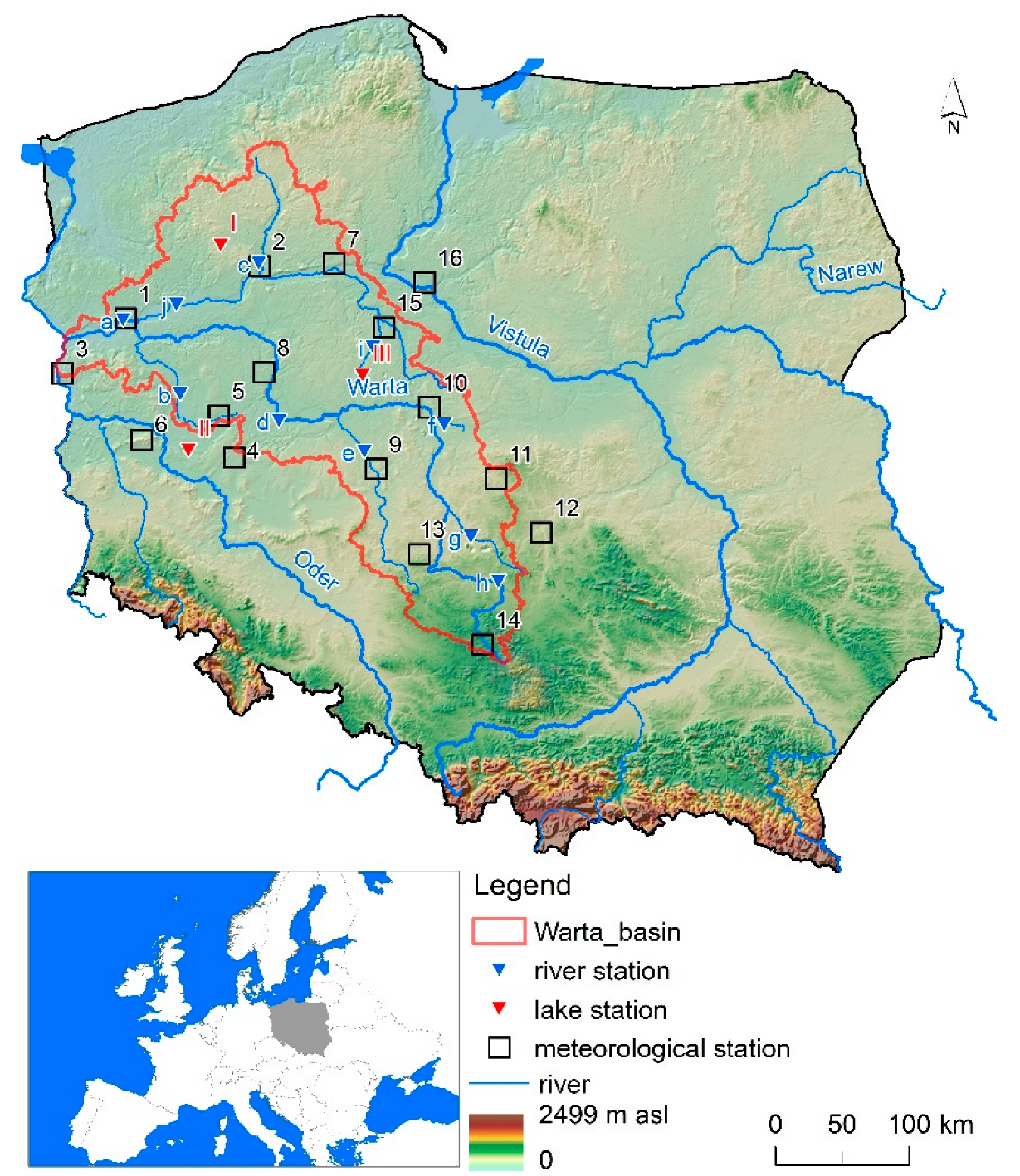
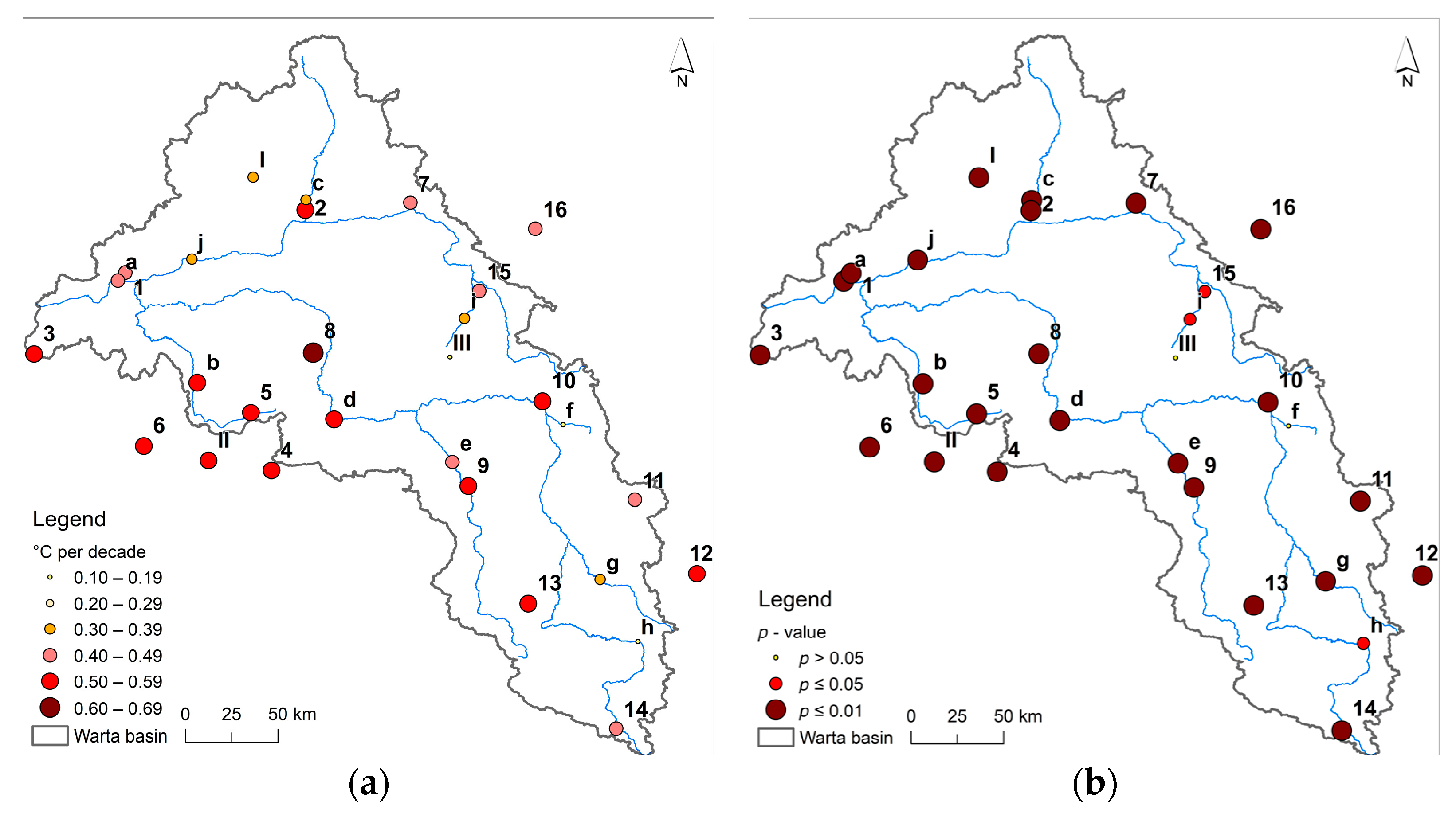
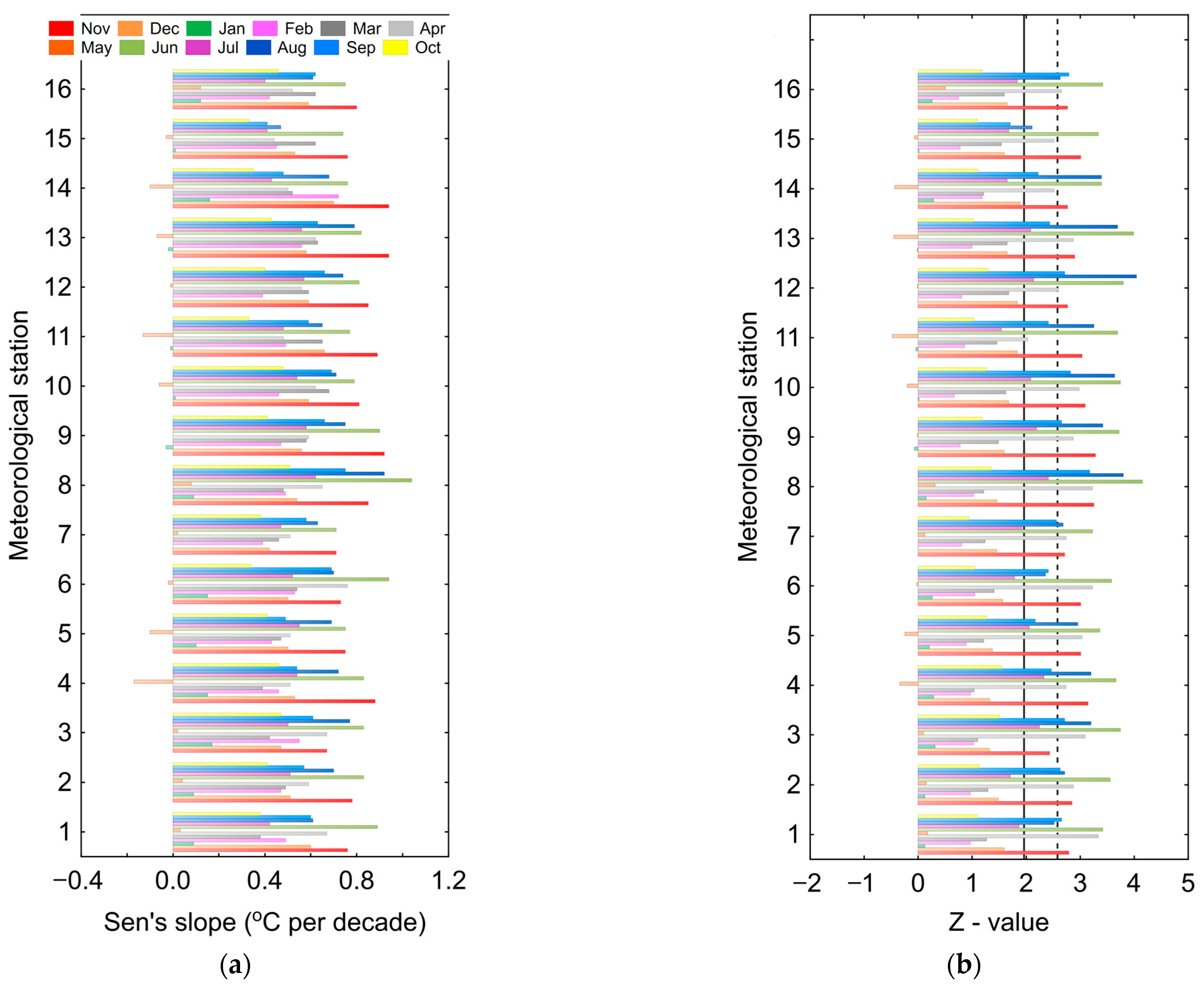

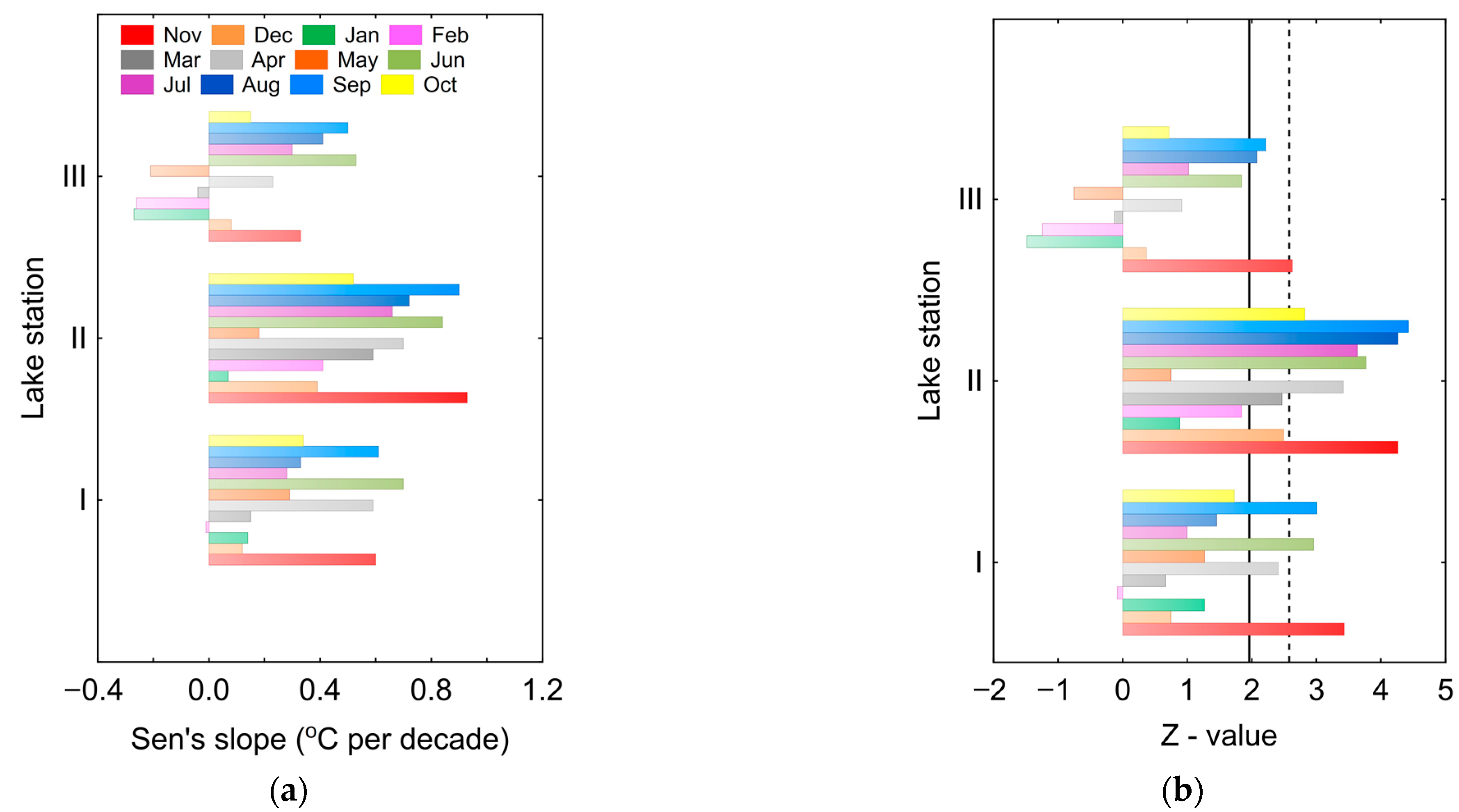
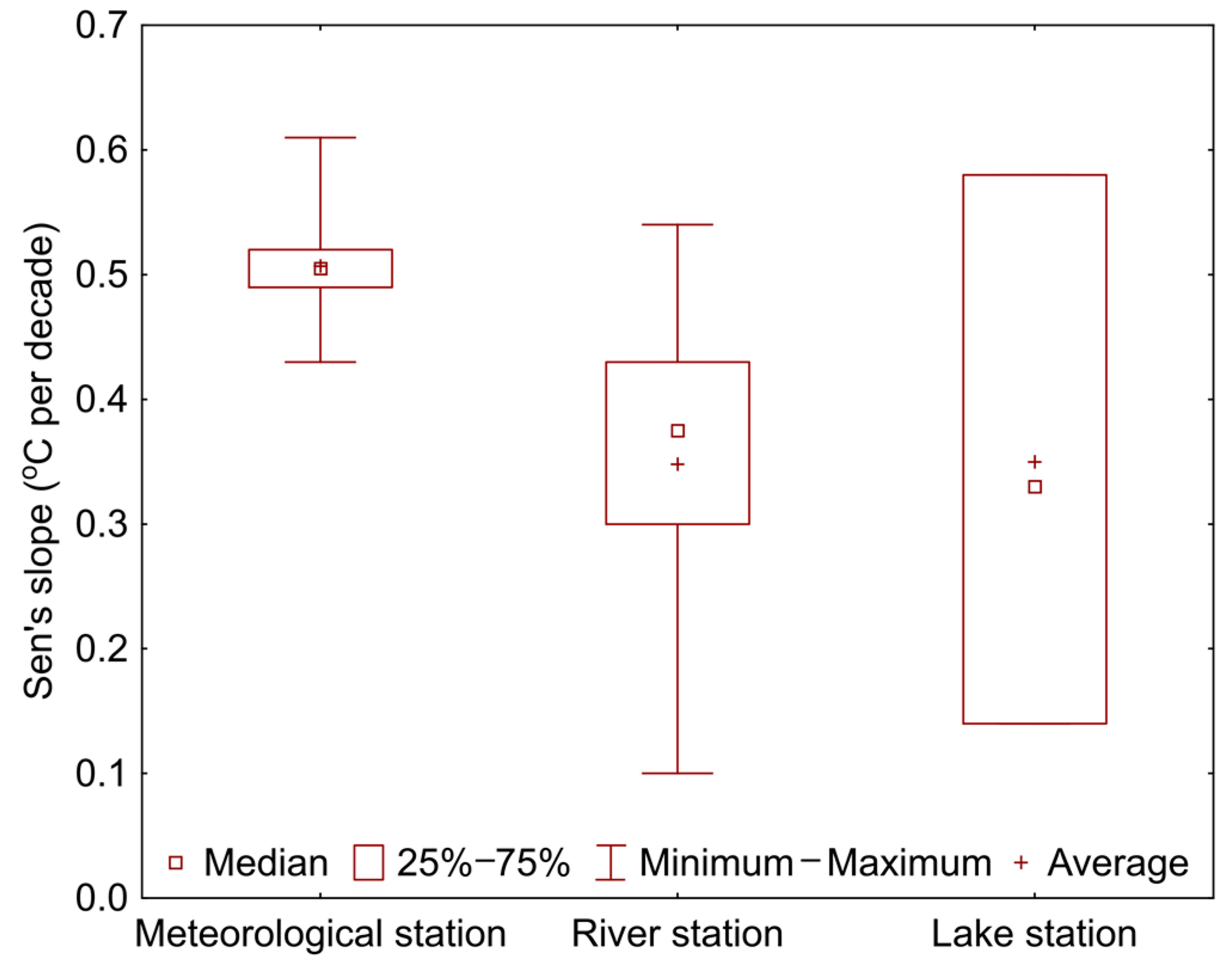
| River-Station | Lake-Station | Meteorological Station |
|---|---|---|
| Warta—Gorzów Wielkopolski (a) | Bytyń Wielki—Nakielno (I) | Gorzów Wielkopolski (1) |
| Piła (2) | ||
| Słubice (3) | ||
| Obra—Zbąszyń (b) | Sławskie—Radzyń (II) | Leszno (4) |
| Wielichowo (5) | ||
| Zielona Góra (6) | ||
| Gwda—Piła (c) | Bytyń Wielki—Nakielno (I) | Chrząstkowo (7) |
| Gorzów Wielkopolski (1) | ||
| Piła (2) | ||
| Warta—Śrem (d) | Powidzkie—Powidz (III) | Leszno (4) |
| Poznań—Ławica (8) | ||
| Wielichowo (5) | ||
| Prosna—Bogusław (e) | Powidzkie—Powidz (III) | Kalisz (9) |
| Koło (10) Poznań—Ławica (8) | ||
| Ner—Dąbie (f) | Powidzkie—Powidz (III) | Kalisz (9) |
| Koło (10) | ||
| Łódź—Lublinek (11) | ||
| Widawka—Szczerców (g) | Powidzkie—Powidz (III) | Łódź—Lublinek (11) |
| Sulejów (12) | ||
| Wieluń (13) | ||
| Warta—Bobry (h) | Powidzkie—Powidz (III) | Lgota Górna (14) |
| Sulejów (12) | ||
| Wieluń (13) | ||
| Mała Noteć—Gębice (i) | Powidzkie—Powidz (III) | Koło (10) |
| Kołuda Wielka (15) | ||
| Toruń (16) | ||
| Noteć—Nowe Drezdenko (j) | Bytyń Wielki—Nakielno (I) | Gorzów Wielkopolski (1) |
| Piła (2) | ||
| Poznań—Ławica (8) |
| River-Staion | Data Availability |
|---|---|
| Warta—Gorzów Wielkopolski (a) | 1984—2010; 2012—2014 |
| Obra—Zbąszyń (b) | 1985—2020 |
| Gwda—Piła (c) | 1984—2015 |
| Warta—Śrem (d) | 1987—2015 |
| Prosna—Bogusław (e) | 1984—2015 |
| Ner—Dąbie (f) | 1985—2015 |
| Widawka—Szczerców (g) | 1985—2015 |
| Warta—Bobry (h) | 1985—2019 |
| Mała Noteć—Gębice (i) | 1985—2020 |
| Noteć—Nowe Drezdenko (j) | 1984—2015 |
Disclaimer/Publisher’s Note: The statements, opinions and data contained in all publications are solely those of the individual author(s) and contributor(s) and not of MDPI and/or the editor(s). MDPI and/or the editor(s) disclaim responsibility for any injury to people or property resulting from any ideas, methods, instructions or products referred to in the content. |
© 2023 by the authors. Licensee MDPI, Basel, Switzerland. This article is an open access article distributed under the terms and conditions of the Creative Commons Attribution (CC BY) license (https://creativecommons.org/licenses/by/4.0/).
Share and Cite
Gizińska, J.; Sojka, M. How Climate Change Affects River and Lake Water Temperature in Central-West Poland—A Case Study of the Warta River Catchment. Atmosphere 2023, 14, 330. https://doi.org/10.3390/atmos14020330
Gizińska J, Sojka M. How Climate Change Affects River and Lake Water Temperature in Central-West Poland—A Case Study of the Warta River Catchment. Atmosphere. 2023; 14(2):330. https://doi.org/10.3390/atmos14020330
Chicago/Turabian StyleGizińska, Joanna, and Mariusz Sojka. 2023. "How Climate Change Affects River and Lake Water Temperature in Central-West Poland—A Case Study of the Warta River Catchment" Atmosphere 14, no. 2: 330. https://doi.org/10.3390/atmos14020330







